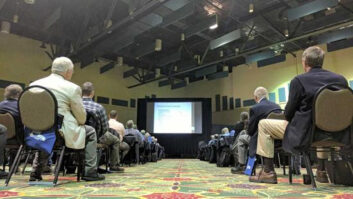Longtime broadcast engineer Ira Wilner is being honored with the 2024 Distinguished Service Award by the Vermont Association of Broadcasters. He’ll be recognized at VAB’s annual Hall of Fame & Awards Gala in November.
“For 50 years, Ira Wilner has been a respected broadcast engineer who has left an indelible mark on dozens of radio and television stations around Vermont and New Hampshire,” VAB stated in its announcement.
In 1950 when he was growing up in New York City, his parents owned one of the first TV sets on the block, a tabletop Magnavox. “The TV repairman was almost a house guest,” Wilner quipped.
His first full-time job was as a college lab technician at Queens College, where he also attended classes. A formative experience for him was signing on the school’s carrier-current broadcast station.

He also vividly recalls playing a digitized recording of Herb Alpert & The Tijuana Brass on a Xerox Sigma 7 research computer for his fellow computer department staffers. “Everyone in the room cheered.”
The sound emanated from a pair of Acoustic Research AR-3a speakers and a Harman/Kardon Citation Twelve audio amplifier attached to a 6-foot rack with a lab-grade D/A converter. The nine-channel data tape with the song was digitized for the college by Bell Labs.
“Today your smartphone can do it without breaking a sweat,” he said.
Attending an electronic music symposium at Dartmouth College, Wilner discovered the White Mountains of New Hampshire; they were among the reasons he and his wife left New York for the greener pastures of New England.
He launched his engineering career in 1977 performing contract-based work under the name Wilner Associates. Among his first clients were the Vermont AM and FM combos of WTSA in Brattleboro and WCFR in Springfield.
“Passionate cheerleader”
“Whether it’s trekking up difficult trails midwinter or flooded swamps in monsoon season to restore transmission systems, or converting analog control rooms to digital without disturbing programming, Ira does what needs to be done to keep broadcast stations operating because he is dedicated to serving the public and helping his colleagues do their work as easily as possible,” the VAB wrote about him.
“Ira is always willing to help other broadcast professionals, even the competition. Whether it’s sharing his vast knowledge and experience, troubleshooting issues or assisting getting a station back on the air after an equipment failure, Ira is a passionate cheerleader for broadcasting.”

For the past two decades he has been chief engineer of the Monadnock Media Group of Saga Communications — which has a stable of AM and FM stations around Brattleboro and nearby Keene, N.H. — while retaining his contract clients.
“The timing was great with my daughter going off to college,” he said of Leah’s acceptance to Smith College. Wilner enjoyed a great relationship with Saga CEO Ed Christian, who was once himself an engineer. Christian died in 2022.
Among his recent accomplishments was putting eight FM translators on the air for Saga’s Brattleboro/Keene HD subchannels and AM properties in 2018. He was able to incur minimal antenna tower downtime by feeding programming via bidirectional digital STLs licensed in the 6 GHz band.
“When I need an additional audio signal on our system, it’s as simple as adding a pair of audio codecs,” he said of the setup, “plug and play with Ethernet patch cords.”
An engineering journey in Vermont would not be complete without encountering Mount Mansfield, the lofty 4,395-foot peak that stands highest in the Green Mountains.
Wilner is well versed with the home of Class C FM signals WVPS and WEZF. He recalls an incident in the 1990s when he needed to take measurements of WVPS’ sister station WVPR, part of the Vermont Public Radio network. WVPS feeds WVPR, and to do the measurements, Wilner needed to silence WVPS. Rather than take it off the air completely, he left the transmitter on, with no audio except for its stereo pilot.
Several days later, Wilner received a call from the FCC. About 75 miles from the summit of Mount Mansfield was Montreal-Dorval International Airport, and technicians there were complaining about an unmodulated signal on 107.9 causing interference with equipment that the airport used in the aviation band.
Wilner recalled that some delicate negotiations were going on at the time between the U.S. State Department and Canadian government. Not wanting to rock the boat, he said, the FCC added an unusual condition to WVPS’ license. The station could never broadcast dead air while radiating an FM signal. But Wilner kept moving onward and he has worked closely with VPR, orchestrating multiple studio rollouts for the statewide radio network.
2,000 reels in his pocket
Wilner can spin many anecdotes and success stories.
By identifying applicants that had been placed into a mutually exclusive (MX) pool but who were no longer interested in obtaining an FM license, he was able to help WOOL(FM) in Bellows Falls secure one. He assisted in putting WVEW(LP) in Brattleboro and WFVR(LP) in South Royalton on the air; he worked with the state Department of Transportation to establish two LPFM travelers’ radio stations in central and northern Vermont.
When the FCC implemented the 6 kW ERP Class A FM maximum, Wilner was able to persuade the commission to grant a power increase to 96.7 WTSA(FM). It agreed to permit the 3 kW ERP station, which had been operating at a lower HAAT than the Class A maximum, to go to 5.2 kW ERP to gain back the coverage area it would have had at 100 meters height.
He co-wrote the original Vermont EAS plan, helped design the state’s original EAS network with Vermont Emergency Management, and serves on the State Emergency Communications Committee. He also led the build of WNNE(TV)’s studios in White River Junction, Vt.
In his spare time, Wilner (W1IRA) is a repeater trustee for the West River Radio Club in Windham County. One of its repeaters resides on a tower owned by Saga. He is an ARRL volunteer exam coordinator and also volunteers for the theatrical group Wild Goose Players. He is fond of photography, dating to when his father bought him an Ansco Box Camera in 1953.
A member of the Society of Broadcast Engineers and the Institute of Electrical and Electronics Engineers, Wilner said he has thoroughly enjoyed mentoring people he has met, from the chief cook and bottle washer at a small-town Vermont station to on-air DJs who have an affinity for the engineering side of radio.
And he takes pleasure in seeing how much audio has changed since he cut his proverbial teeth on reel-to-reel audio tape. “When I started out, a 10-1/2-inch reel could record one hour of programming with a little background hiss at –60 dBFS,” Wilner said. “Today, I can carry over 2,000 10-inch reels worth of noise-free audio on a 3/4-inch-square, 2 terabyte memory card.”







